#kuniko tsurita
Photo

Yuko’s Days - Kuniko Tsurita
261 notes
·
View notes
Text

kuniko tsurita’s to the other side - kuniko tsurita unpublished works || つりたくにこの『彼方へ―つりたくにこ未発表作品』
#kuniko tsurita#りたくにこ#to the other side#kuniko tsurita unpublished works#kanata e#彼方へ#つりたくにこ未発表作品集#b&w#mangacap
44 notes
·
View notes
Text


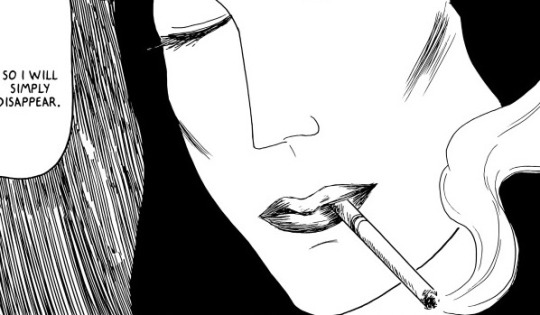

‘max’: the sky is blue with a single cloud, (1975) // interview with the vampire, ‘a vile hunger for your hammering heart’ (2022)
#yn.#iwtv#max#kuniko tsurita#louis de pointe du lac#the sky is blue with a single cloud#☀️#shoujosei
29 notes
·
View notes
Photo

Redraw of a page in The Sky is Blue with a Single Cloud by Kuniko Tsurita
#the sky is blue with a single cloud#Kuniko Tsurita#redraw#art#comic#i had a lot of work with that armchair pattern#thank you#feeling really trans because of this page im still not sure why#btw i didnt redraw the cigarette because i dont smoke and its has a lot of bad memories
4 notes
·
View notes
Text



The Good Book Every Sunday:
The Sky Is Blue with a Single Cloud
by Kuniko Tsurita
Drawn & Quarterly, first edition, July 2020
Emily Dickinson would've LOVED this manga. She would've thrown this in a rucksack, with an apple or two, called for Carlo, and would've settled herself in a meadow and read cover-to-cover, thence haply drowse away.
The evidence found between the covers of this book show that Tsuri is clearly a master: every sure-footed, clearly delineated line of inky perfection that make up the drawings is heartfelt and vibrating with the diamond-hard imagination of a bird in flight.
While I, nor Emily, know a lick of Japanese, and so miss a great deal of her poetic discourse, it is obvious that we are brought to the gates of an earthly paradise so smartly designed, where image and text are so tightly woven, we believe the cloth of this work will keep us warm forever.
0 notes
Text
Disability in Graphic Novels #1
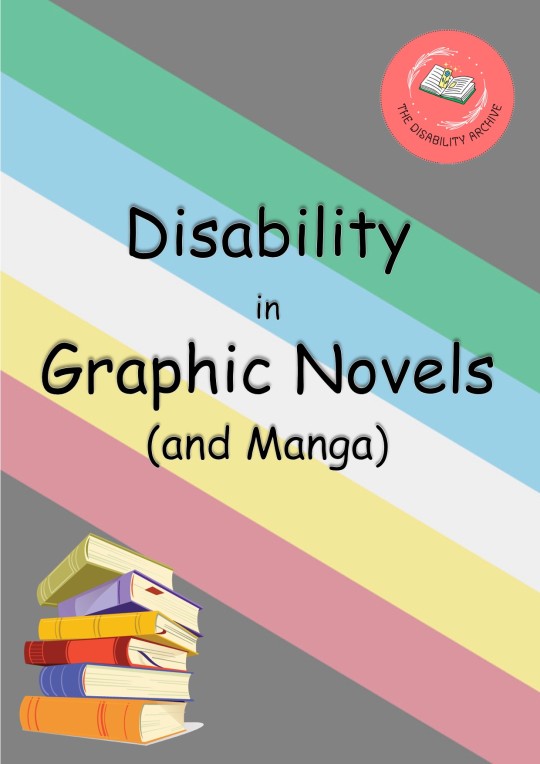
[ID: A poster reading "Disability in Graphic Novels (and Manga)" in black writing in the centre. A small, circular logo is in the top right corner. It is red with an open book in the middle, white leaves around the book, and the word "The Disability Archive" across the bottom. In the lower left corner, cartoonish clipart of a colourful stack of books. All of this is overlayed onto the disability pride flag. /end]
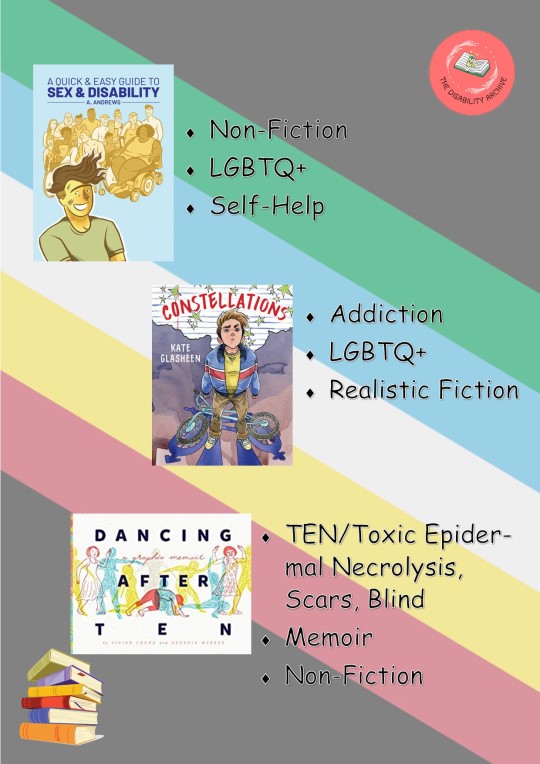
[ID: The same poster, edited. The writing has been removed and replaced by three book covers, with bulleted lists next to each. The images in both corners have been shrunken slightly. The book covers, from top to bottom, are:
"A Quick & Easy Guide to Sex & Disability"
The phrases "Non-Fiction", "LGBTQ+" and "Self-Help" are listed next to it.
"Constellations"
The phrases "Addiction", "LGBTQ+" and "Realistic Fiction" are listed next to it.
"Dancing after TEN"
The phrases "TEN/Toxic Epidermal Necrolysis, Scars, Blind", "Memoir" and "Non-Fiction" are listed next to it. /end]

[ID: The same poster, with three different book covers. The book covers, from top to bottom, are:
"Everything Is An Emergency"
The phrases "OCD", "Memoir" and "Non-Fiction" are listed next to it.
"Frankie's World"
The phrases "Autism", "Ireland" and "Middle-Grade Realistic Fiction" are listed next to it.
"The Golden Hour"
The phrases "Anxiety, PTSD", "LGBTQ", "Realistic/Contemporary" and "Gun Violence" are listed next to it. /end]
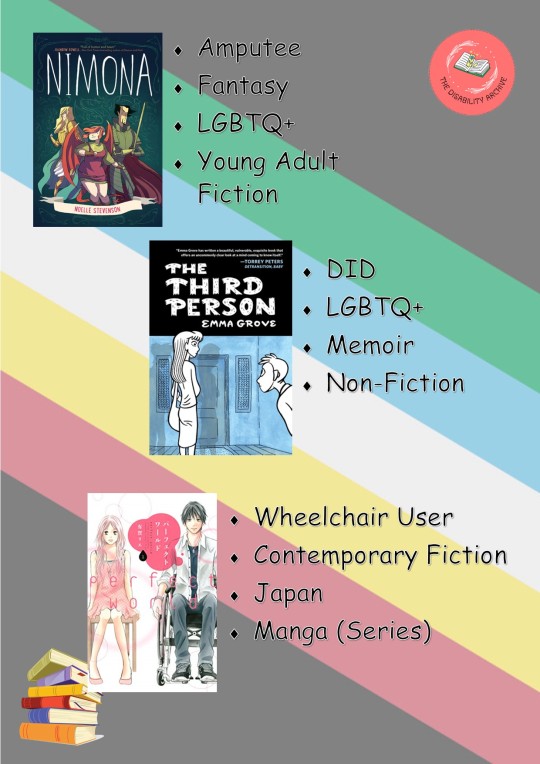
[ID: The same poster, with three different book covers. The book covers, from top to bottom, are:
"Nimona"
The phrases "Amputee", "Fantasy", "LGBTQ+" and "Young Adult Fiction" are listed next to it.
"The Third Person"
The phrases "DID", "LGBTQ+", "Memoir" and "Non-Fiction" are listed next to it.
"Perfect World"
The phrases "Wheelchair User", "Contemporary Fiction", "Japan" and "Manga (Series)" are listed next to it. /end]
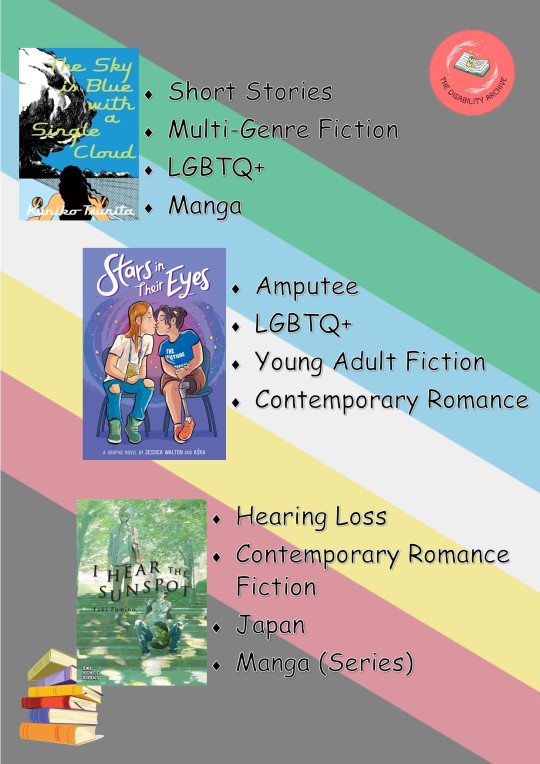
[ID: The same poster, with three different book covers. The book covers, from top to bottom, are:
"The Sky is Blue with A Single Cloud"
The phrases "Short Stories", "Multi-Genre Fiction", "LGBTQ+" and "Manga" are listed next to it.
"Stars in Their Eyes"
The phrases "Amputee", "LGBTQ+", "Young Adult Fiction" and "Contemporary Romance" are listed next to it.
"I Hear the Sunspot"
The phrases "Hearing Loss", "Contemporary Romance Fiction", "Japan" and "Manga (Series)" are listed next to it. /end]
---
A collection of graphic novels and manga featuring disabled characters and/or discussions of disability!
I don't know if there'll be a part 2 to this, but if there is I might try and make it just a bit shorter.
Book List:
'A Quick & Easy Guide to Sex & Disability' by A. Andrews
'Constellations' by Kate Glasheen- Addiction
'Dancing After TEN: a graphic memoir' by Vivian Chong, Illustrated by Georgia Webber- Toxic Epidermal Necrolysis (TEN), Scarring, Blind
'Everything Is an Emergency: An OCD Story in Words Pictures' by Jason Adam Katzenstein- Blind
'Frankie's World' by Aoife Dooley- Autism
'The Golden Hour' by Niki Smith- Anxiety, PTSD
'Nimona' by N. D. Stevenson- Amputee
'The Third Person' by Emma Grove- DID
'パーフェクトワールド |Perfect World|' by Rie Aruga- Wheelchair User
'The Sky is Blue with a Single Cloud' by Kuniko Tsurita
'Stars in Their Eyes' by Jessica Walton and Aśka- Amputee, Prosthetic Leg
'ひだまりが聴こえる |I Hear the Sunspot|' by Yuki Fumino- Hearing Loss/Hard of Hearing
#books#disability#disability books#book list#graphic novels#manga#disability literature#disability representation#disabled characters#resources#disability resources#book resources#booklr#part 1#graphic novels part 1#images#image descriptions#alt text#long post#caps
97 notes
·
View notes
Text
My Journey with Garo
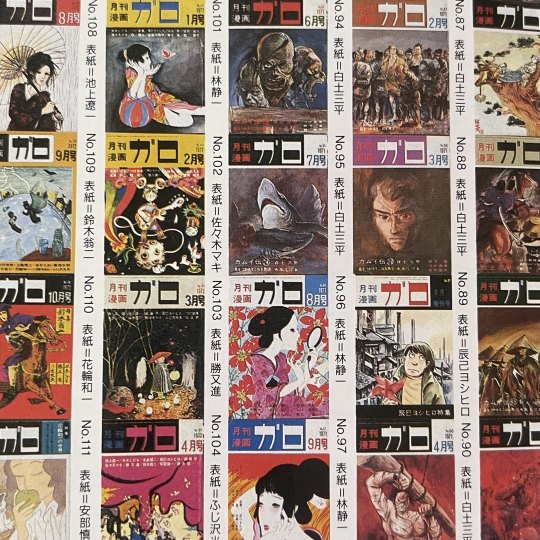
Extract of Garo issue cover art from the Garo Mandala (1991)
It must've been near the end of 2022 when I discovered the treasure trove that is the Monthly Manga Garo, a legendary alternative manga magazine that ran from 1964 to 2002 that thrived against the backdrop of a politically turbulent post-war Japan. In the English market now, we're fortunate enough to be getting a wide variety of translated works from some of the manga greats who had serialised in Garo. From pillars like Tsuge Yoshiharu and Shirato Sanpei to the heta-uma king Ebisu Yoshikazu, you won't ever be bored with the sheer variety of stories, art styles and subject matter that can be seen throughout Garo's lifetime. Pick up any issue and you'll be surprised as to how many types of stories will grace your eyes.
Now back to my personal experience with Garo. I had seen a Garo issue for the very first time through one of Shawn's videos from Japan Book Hunter, a manga plug that I've used for amazing and rare manga that you won't be able to find anywhere except in Japan's jungle of bookstores. His YouTube channel at the time was uploading extremely interesting manga hauls that touched upon a wide variety of lesser-known genres and niches in Japanese comics. There were alternative manga, Shoujo horror, SF, gag and all the other gritty stuff from the wider world of manga outside the usual Shounen Jump. I watched his channel religiously and still look back on some videos to this day, reflecting on how far I've come in learning about manga and manga history. Huge shoutout to Shawn and his store, check him out!
After moving away from the more well-known Seinen and Shounen titles in search of more to explore, my foray into alternative and underground manga was one of the most enlightening experiences in my reading journey. I'd equate my discovery of Garo to my first reads of Borge's short stories, both mind-blowing experiences that have completely transformed my tastes in fiction forever. Garo and my subsequent dives into other alternative manga have now created an insatiable curiosity into what else could be hidden out there in the largely untranslated world of manga. It seems like going backwards in time is the direction I'm taking, but I haven't even scraped the tip of the iceberg yet with Garo, let alone other niches like Shoujo horror and Kashihon. Slowly I'm completing issue after issue, gradually exposing myself to a legendary group of mangaka and artists that have cemented themselves in a magazine that I feel stands the test of time.
At this moment, I have about 40-ish Garo issues on my shelves, and I've read maybe 15 of those. It's a slow reading process, but it's insanely worth it. Each decade is vastly different from the others, so it's extremely fascinating to see the evolution of the magazine over time. For example, starting off in the 60s you have the legendary Kamui-den by Shirato Sanpei, a ninja tale set in feudal Japan that involves social/political commentary on topics like class conflict and oppression. The series was responsible for the birth of Garo because founder Katsuichi Nagai, who I believe was already experienced in the kashihon market, had wanted to give a platform for Shirato to serialize his work. Many stories in the 60s era of Garo were more politically expressive, coinciding with a lot of the unstable politics at the time in Japan. Other mangaka largely present throughout 60s Garo include Mizuki Shigeru, Tsuge Yoshiharu, Nagashima Shinji, Takita Yuu, Tsurita Kuniko and many more.

Various Garo issues from my bookshelf
Then, you move into the 70s. This is where mangaka and artists like Hayashi Seiichi, Tsuge Tadao, Susumu Katsuma and Abe Shinichi start to become more present in the spotlight and appear more frequently in issues. A more surreal and weirder style of stories begin to appear in this decade, marking a key period for Gekiga in my opinion. Personally, when I think Gekiga, my mind goes to people like Hayashi, Tatsumi, Tsuge and Abe, so it's a time that I feel was a very important one for Garo.

Flowering Harbour - Hayashi Seiichi (Garo 1969 May)
The majority of my Garo reads have been towards the tail end of the 60s, with some reads spread throughout the 70s and 90s. Funnily enough, I don't think I have many issues from the 80s. From what I've read from the later decades of Garo though, I've fallen deeply in love. Going from the Tsuges, Hayashis and Mizukis to a whole new world of more contemporary mangaka like Usamaru Furuya, Kawai Katsuo and Maruo Suehiro opened up an even bigger obsession for the magazine. You have an influx of ero-guro (erotic-grotesque) and heta-uma (bad-good) in the scene that introduced a great deal of new names, a lot of whom had also continued into Ax magazine, the spiritual successor to Garo, after the magazine's end. I can make a whole other post on Ax, but that's for another day.

My Youth - Maruo Suehiro (Garo 1983 August)
That about sums up my journey reading Garo from discovery to this current point in time. With 426 issues spanning from the 60s to the early 2000s, I'm not going to run out of issues to read anytime soon. Maybe in a future post, I'll talk more in-depth about specific mangaka and artists that I enjoy. But anyways, thanks for reading my first blog post if you've come this far! Hoping to get out more posts in the future because it really scratches an itch for me when I can express all my thoughts like this in an extended post format.
9 notes
·
View notes
Photo

My Wife is an Acrobat - Kuniko Tsurita
68 notes
·
View notes
Photo
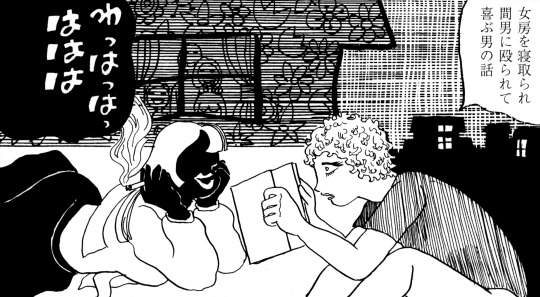
kuniko tsurita’s to the other side - kuniko tsurita unpublished works || つりたくにこの『彼方へ―つりたくにこ未発表作品』
#kuniko tsurita#りたくにこ#to the other side#kuniko tsurita unpublished works#kanata e#彼方へ#つりたくにこ未発表作品集#b&w#mangacap
41 notes
·
View notes
Text

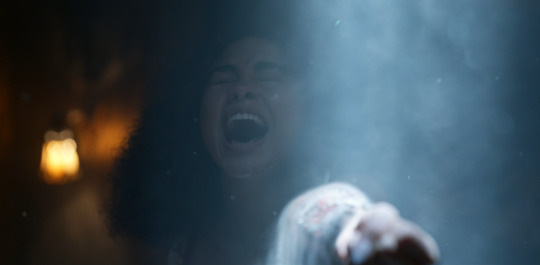
And, diary, you'd think a girl whose mama died in childbirth... whose daddy gave her away to a mean old auntie who beat her 'cause no one said she couldn't, who died in a fire but came back by the blood magic of two demons, well, you'd think that girl wouldn't know what funny was. But you'd be wrong, diary. And if I told you, dumb diary, that that same girl was being raised to kill like her demon parents did, to take two souls a day so she could stay in the same flat-chested, hairless-crotched 14-year-old baby doll body as her mind and spirit turn 19, 20, 25, 63, 358, you dumb, dumb diary, I bet you'd say to anyone who'd listen, "Fun? Fun? How does she even get up in the morning?" Well, let me tell you something, you stuck-up, flower-covered, three-dollar fancy fսcking paper diary, I'm doin' just fine.
17 notes
·
View notes
Photo

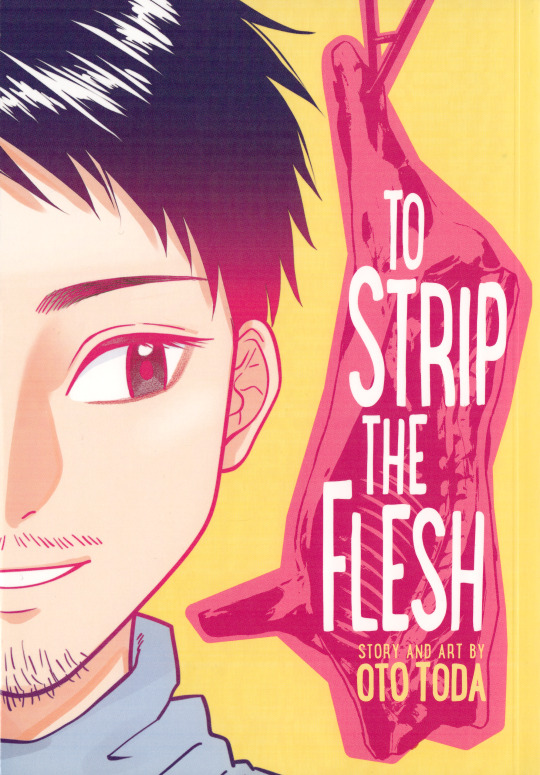

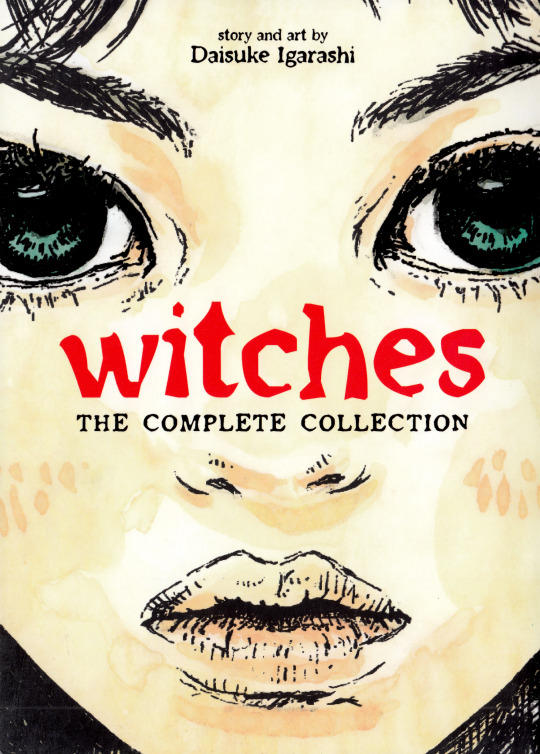




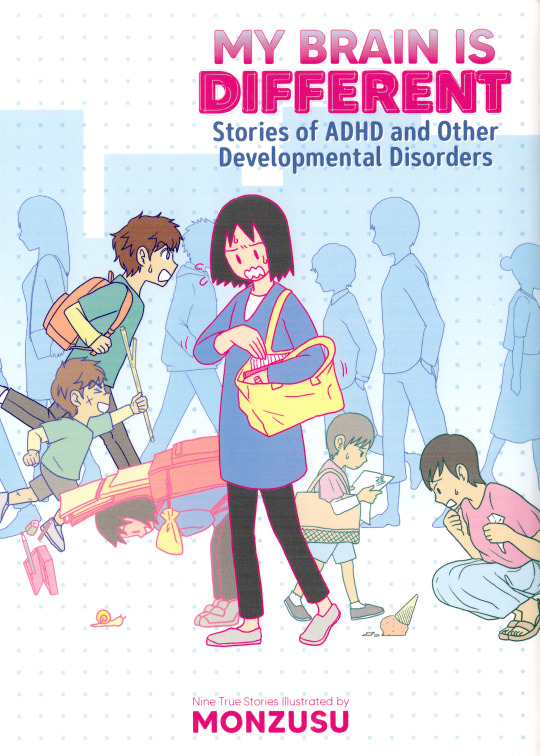
2022 YEAR ROUNDUP: FAVORITE RELEASES OF THE YEAR
Another year has passed, so here’s the much overdue yearly roundup! First is titles that were released in 2022:
Talk To My Back by Yamada Murasaki [Drawn & Quarterly, trans. Ryan Holmberg]
To Strip The Flesh by Oto Toda [Viz Media, trans. Emily Balistrieri]
Came The Mirror & Other Tales by Rumiko Takahashi [Viz Media, trans. Junko Goda]
Witches by Daisuke Igarashi [Seven Seas, trans. Kathryn Henzler]
Box of Light by Seiko Erisawa [Seven Seas, trans. Daniel Komen]
童夢 (Domu: a Child’s Dream, Otomo The Complete Works edition) by Katsuhiro Otomo [Kodansha]
Daily Report About My Witch Senpai by Maka Mochida [Seven Seas, trans. Liya Sultanova]
Orochi by Kazuo Umezz [Viz Media, trans. Jocelyne Allen]
My Brain Is Different: Stories of ADHD and Other Developmental Disorders by Monzusu [Seven Seas, trans. Ben Trethewey]
I cherish every anthology manga that makes it to english and when we got “To Strip the Flesh”, “Came the Mirror”, “Box of Light” “Witches”, and “Orochi” we truly struck gold. I’ve been waiting for Igarashi to get another shot at the english language market, and then Orochi and the announcement of the new Cat-eyed Boy editions confirmed that Umezz’s is back to stay, crossing my fingers for a major title like My Name Is Shingo or Fourteen next.
I will count Box of Light among the anthologies as the stories presented in each chapter stand so well on their own. I will never say no to a fun take on the liminal space between life and death.
Essay manga I can now say has become a regular part of the licenses American publishers hand us, and I will gladly read every single one of them. This year my favorite was by far “My Brain Is Different”. A painful but much needed collection of personal accounts from adults and their life long struggles living with autism and ADHD.
D&Q has barely missed with their alternative manga picks as well as their korean manhwa licenses. Now it appears they’re ready to showcase more women from this scene and Talk to My Back was an amazing way to follow up The Sky is Blue With a Single Cloud by Kuniko Tsurita. This simple chronicle of a housewife and her family accompanied with an impressive and detailed write-up of Murasaki’s career was a great read that I will absolutely come back to again and again.
The return of Domu was a grand and long awaited one as this series has been out of print in its native country for quite some time. This XL sized edition contained not just color pages and previously uncompiled chapter covers plus a look back on the making of the manga, including photos of the real life housing complex the story takes place in. Hoping an english edition of the same caliber will follow suit in the near future!
And Witch-Senpai is just a simple romance I found myself feeling very engaged in and was one of the first titles that came to mind when putting this list together.
40 notes
·
View notes
Text
Author Spotlight: つりたくにこ | Kuniko Tsurita
A short look into the life and work of the mold breaking mangaka, Kuniko Tsurita- an artist active from the 1960s through to her death in 1985, who would become the first female contributor published in the legendary Japanese alt-manga magazine 'Garo'.
2 notes
·
View notes
Text
the English Kuniko Tsurita anthology has a really interesting critical essay at the back on her life and work but one thing that stuck out to me was when they were talking about how in her comics, she portrayed her self-insert as an introverted goofball, but in real life people found her brusque and unapproachable. she hung out at the edges of the bohemian leftist scenes she was writing about, but didn’t have a lot of close friends. some people in her work circle thought that her register was trying too hard to sound intellectual and that she was pretentious (she never went to university but taught herself a bunch of languages and read widely). like man I can sympathize with that. I wonder if she was autistic.
#I had quite a strong emotional reaction to the book#the essay and chosen stories fit together well to give a picture of her art and life
6 notes
·
View notes
Text
JVC Post #5
Kamuiden was very enjoyable, and It's undoubtedly a huge change in aesthetics from the previous readings. Soon after Tezuka Osamu helped blast manga into popularity, gekiga emerged as a direct challenge to the more childish manga aimed at kids that dominated the market, and Kamuiden seems to be a great example of that. The more grizzled and intense art style in addition to the more brutal and adultish themes/scenes mark this as markedly different than earlier manga like Tetsujin 28-gou or Sazae-san.
I can definitely see the societal and political themes within th work as mentioned by Kinsella in Adult Manga. Kamuiden is much more forward with it's commentary on class and resistance, at least compared to children's manga. I find it really interesting that this genre shift was also largely responsible for shifting the primary demographic for manga towards young adults. Kinsella provides really great insight into this shift.
Its also interesting to think about how manga and gekiga were viewed by people at the time. Obviously manga was associated with a clean, childish image, and gekiga with a rougher, rebellious image. I also enjoyed learning that manga grew through university students being into more serious manga with political undertones. I think there are a lot of examples of univeristy students contributing to big advances in the arts. I was glad they mentioned Ashita no Joe as well, if only briefly. To think manga would have such a profound affect on politics. Or maybe the further insertion of politics had a profound affect on manga?
In regards to Kamuiden: The fact that it was published in GARO was also cool to learn. I'm a fan of a lot of the works that were published in GARO. Like Kinsella mentions, a lot of experimental, avant-garde, and otherwise offbeat material made its way into GARO, and its clear that the surfacing of this kind of material began to showcase just how much potential manga had as an art form. From what I can tell, gekiga in it's own right was also quite experimental comparing it to its mainstream contemporaries.
If you want to check out some of the avant-garde and offbeat material published in GARO, here are some of my recommendations:
Nekojiru Udon by Nekojiru
(^ also known as Cat Soup)
The Color of Rain (雨の色) by Oji Suzuki (untranslated)
The Tragedy of Princess Rokunomiya (六の宮姫子の悲劇) by Kuniko Tsurita (untranslated)
(^ One of my favorites. Kuniko Tsurita wrote lots of great stuff, but not a lot of it is easily available)
Lots of GARO media goes untranslated officially for what I assume is economic reasons, but if you can read Japanese they released a massive collection which is available on the internet archive. The hyperlink goes to 六の宮姫子の悲劇。

0 notes
Text




ONESHOT MULTI-FEATURE (L -> R)
and so, i said - shibaya shiyu
cw: rape, bullying
a young girl is given a big choice about the fate of the world
girlfriend - okajiro
two inseparable girls think about their futures
night… - tsurita kuniko
a young man’s night out
hametsu - mizue komadori
a surreal experience
#manga post#manga#oneshot#night#hametsu#girlfriend#and so i said#horror#modern romance#manga recommendation#yuri#GL
0 notes
